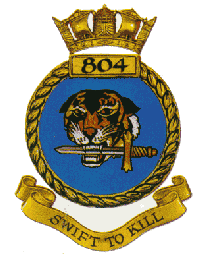804 Naval Air Squadron
| 804 Naval Air Squadron | |
|---|---|
 |
|
| Active | November 1939-July 1944 1944-45 1946-55 1956-59 1960-61 |
| Country | United Kingdom |
| Branch | Royal Navy |
| Type | Carrier based fighter squadron |
| Part of | Fleet Air Arm |
| Motto(s) | Swift to Kill |
| Battle honours | Norway 1940 North Africa 1942 Normandy 1944 Burma 1945 Korea 1951-52 |
804 Naval Air Squadron (804 NAS) was a Naval Air Squadron of the Royal Navy, formed in November 1939 from part of 769 NAS Sea Gladiators which had been detached to RNAS Hatston. The squadron was merged into 800 NAS in June 1944 and subsequently reformed in September.
During World War II, she was equipped with various aircraft types in differing roles. When formed at Hatston, 804 used Gloster Sea Gladiators in defence of the naval base at Scapa Flow, but was transferred in April 1940 to HMS Glorious to provide air cover for the ferrying of 269 Squadron RAF's Gladiators to Norway after the German invasion. This was a brief assignment and in early May the squadron was transferred to HMS Furious at Campbeltown, thus missing Glorious' sinking. Between May and September 1940 804 squadron returned to Hatston, and was subsequently recognised as one of the two FAA squadrons that operated with RAF Fighter Command in the Battle of Britain.
In October 1940 804 Squadron was re-equipped with Martlet I fighters, and first operated the new fighters out of RNAS Skaebrae in the Orkney Islands in October 1940. On 25 December 1940, two of the squadron's Martlets shot down a Junkers Ju 88 off Scapa Flow, thus scoring the first aerial victory in Europe by any variant of the Grumman F4F Wildcat. Further re-equipping occurred in February 1941 at RNAS Yeovilton with Fulmar IIs and Sea Hurricanes.
...
Wikipedia
